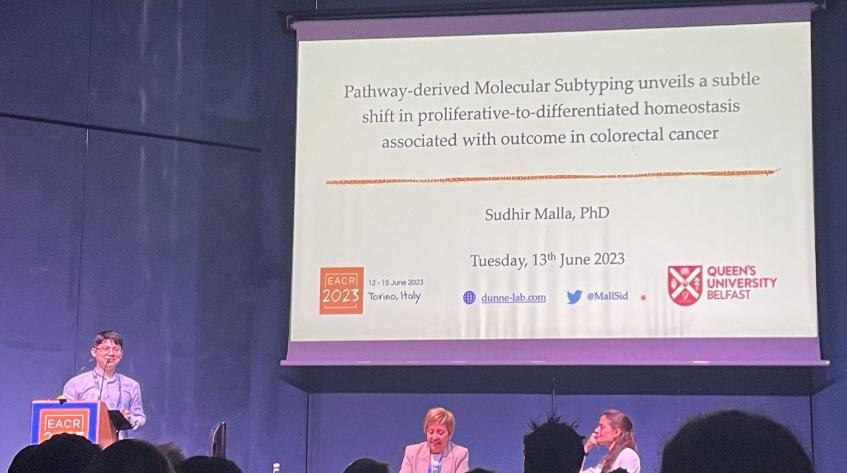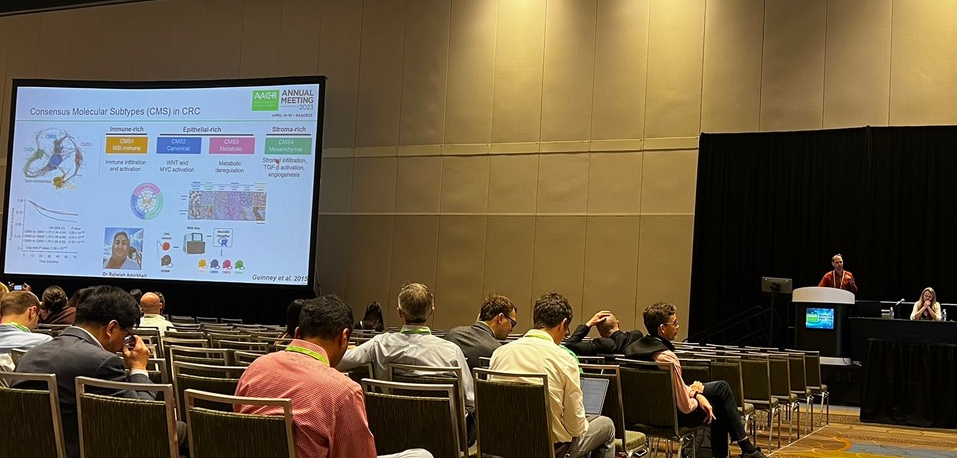They Walk the Walk, Then Give the Talk…
PGJCCR Researchers Take Digital Oncology to the International Stage!
Researchers from the Patrick G Johnston Centre for Cancer Research (PGJCCR) have been taking to podiums across the globe to highlight a novel approach to cancer research which involves an innovative use of a combination of computer programming, digital pathology and molecular biology.
Conference attendees in Turin, Liverpool and Florida have been hearing about the emerging field of digital oncology, which draws in a range of scientists from backgrounds that would previously have not directly been associated with the fight against cancer.

While a combination of biology and computer science has been around for a number of years, termed bioinformatics, a new approach being developed in Belfast goes much further, by combining patients’ information derived from cancer treatment centres and clinical trials units with diverse data from pathology and numerous genomic studies. The outputs from this work have enabled teams around the UK and EU to maximise the value of existing information from these diverse collections and has led to a series of remarkable new insights into the driving forces involved in cancer development and progression.

Dr Sudhir Malla, a postdoctoral researcher based in PGJCCR was recently invited to present his work to over 1,500 cancer researchers at the prestigious European Association for Cancer Research (EACR) annual conference in Turin, Italy. Dr Malla remarked:
“It is through the combination of each of these data types that our research team has revealed a number of previously overlooked subtle patterns in molecular and histological information, reinforcing the importance of using multiple tiers of cancer-relevant information that cannot be fully revealed by individual methods alone.”
This new synergistic approach has been developed in Belfast to react to the sheer volume and complexity of data now being produced across cancer treatment and research centres. This has resulted in the generation of massive “data lakes” that rarely realise their full potential to advance biomedical research due to the specialised computational skills required for data integration and analysis.
Speaking after presenting her work to the Pathological Society of Great Britain & Ireland annual conference in Liverpool, Dr Natalie Fisher explained:
“Our work reinforces the value of advances being made in each individual field of cancer research, all of which are improving the lives of cancer patients. What is different about our approach is that it demonstrates the value of how unique combinations of this existing information, that is otherwise being looked at in isolation, can provide valuable new insights into cancer biology and pathology.”
To do this, the team in Belfast have assembled researchers with background training in computer programming, digital pathology, immunology and cancer biology, to work in tandem on the same data and to develop computational approaches to combine and understanding this information. The value of the outputs has been recognised across the cancer research spectrum, revealing previously unseen relationships between patient outcomes, digital pathology images and genetic information derived from tumour tissue.
Dr Philip Dunne, Reader in Molecular Pathology at QUB and Group Leader at the Cancer Research UK Beatson Institute in Glasgow, was recently invited to present his groups approach to over 20,000 researchers attending at the American Association of Cancer Research (AACR) annual conference in Florida commented:
“We always anticipated that we would generate new understanding through an assessment of multiple tiers of information about the features and mechanisms ongoing within tumour tissue and the clinical outcomes from the patients they were removed from. What has taken us by surprise is the ability of our new findings to fill gaps in our understanding of so many outstanding tumour biology questions, in a way that are only revealed using the approaches being developed by early career researchers like Dr Malla and Dr Fisher.”

This approach has already made a significant impact in terms of how the overall cancer research field interprets data derived from tumours samples, enabling many new disciplines to become involved in this new cancer research approach. A number of cancer research agencies and funders have realised that in order to make full use of the cancer data being produced in studies they fund, this now also requires support for this new wave of digital oncologists.
Dr Dunne concluded: “For a while now, the public has been aware of the “bench-to-bedside” approach in cancer research, which strives to align laboratory work with patient care. We are delighted to see research funders react so quickly to the emergence of this new digital oncology research discipline and believe that the approaches we are highlighting on the world stage will show the public the value of combining this standard approach with the novel computational-based “bytes-to-bedside” research ongoing in our research centre.
